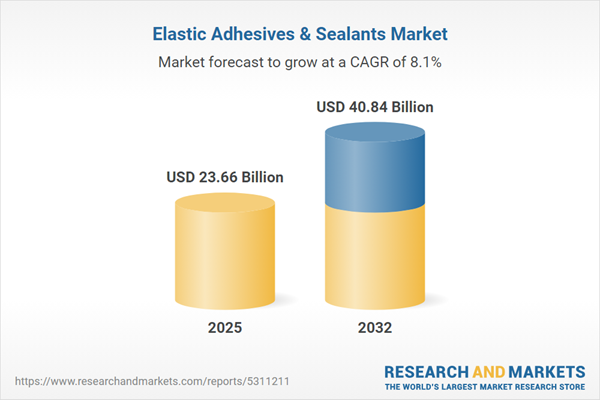Speak directly to the analyst to clarify any post sales queries you may have.
Senior leaders face intensifying challenges in the elastic adhesives and sealants market as innovation, environmental mandates, and changing global trade dynamics alter the competitive landscape. In this complex environment, robust market intelligence is essential for effective strategic planning and resource allocation.
Market Snapshot: Elastic Adhesives & Sealants Market Overview
The elastic adhesives and sealants market has shown resilient growth, advancing from USD 21.92 billion in 2024 to USD 23.66 billion in 2025, and projected to expand at a CAGR of 8.09% reaching USD 40.84 billion by 2032. Expansion is fueled by sustained demand for flexible, chemically resistant bonding solutions across automotive, aerospace, construction, electronics, and packaging sectors. New materials and sustainability-focused developments are supporting widespread adoption and driving market entry for innovative players.
Scope & Segmentation
- Resin Types: Polysulfide, Polyurethane (PU), Silicone, Silyl-Modified Polymers (SMP/MS Polymer)
- Packaging Types: Bulk, Cartridge, Sachet, Tube
- Application Methods: Automated, Manual
- End User Industries: Aerospace and Defense (Commercial Aviation, Military and Defense), Automotive (Aftermarket, OEM), Construction (Commercial, Infrastructure, Residential), Electronics and Electrical (Consumer Electronics, Industrial Electronics), Packaging (Flexible, Rigid)
- Distribution Channels: Direct Sales, Distributor, Online Retail
- Regions: Americas, Europe Middle East and Africa, Asia-Pacific
- Americas: North America (United States, Canada, Mexico), Latin America (Brazil, Argentina, Chile, Colombia, Peru)
- Europe Middle East and Africa: Europe (United Kingdom, Germany, France, Russia, Italy, Spain, Netherlands, Sweden, Poland, Switzerland), Middle East (United Arab Emirates, Saudi Arabia, Qatar, Turkey, Israel), Africa (South Africa, Nigeria, Egypt, Kenya)
- Asia-Pacific: China, India, Japan, Australia, South Korea, Indonesia, Thailand, Malaysia, Singapore, Taiwan
- Featured Companies: Henkel AG & Co. KGaA, 3M Company, Sika AG, H.B. Fuller Company, Arkema S.A., Dow Inc., Avery Dennison Corporation, RPM International Inc., Eastman Chemical Company, Illinois Tool Works Inc.
Key Takeaways for Senior Decision-Makers
- Adoption of elastic adhesives and sealants is accelerating due to their capability to withstand dynamic stresses and temperature fluctuations, essential in advanced manufacturing and construction.
- Innovative chemistries—including bio-based and silyl-modified polymers—are central to both performance enhancement and meeting tightening global environmental standards.
- Digitized production environments and precision dispensing technologies are improving quality control and process efficiency in end-user industries.
- Supply chain scrutiny is increasing, with blockchain and advanced analytics enabling real-time raw material traceability and transparency.
- Strategic partnerships and cross-functional development are expediting commercialization of new low-carbon and smart adhesive solutions, supporting long-term competitiveness.
Impact of United States Tariffs in 2025
Revised US tariffs on key resin precursors and specialty additives have driven up import costs, compelling manufacturers to re-examine sourcing strategies and increase domestic production capacity. These shifts are reshaping global value chains, prompting investment in supply chain resilience and vertical integration to mitigate risks and stabilize pricing.
Methodology & Data Sources
This report is based on structured interviews with sector experts, extensive reviews of peer-reviewed publications and financial disclosures, and detailed segmentation analysis. Quantitative projections are validated through advanced statistical models and subject matter expert panels, supporting actionable accuracy for business decisions.
Why This Report Matters
- Gain a comprehensive understanding of the elastic adhesives and sealants market, with insights into technological, regulatory, and regional developments relevant for strategic planning.
- Benchmark competitive positioning and innovation strategies against leading players for informed investment and market entry decisions.
Conclusion
Organizations that adopt agile innovation, optimize supply networks, and persistently align with environmental demands will be best positioned for growth. This report provides frameworks and intelligence essential for resilience and value creation in the evolving elastic adhesives and sealants market.
Additional Product Information:
- Purchase of this report includes 1 year online access with quarterly updates.
- This report can be updated on request. Please contact our Customer Experience team using the Ask a Question widget on our website.
Table of Contents
3. Executive Summary
4. Market Overview
7. Cumulative Impact of Artificial Intelligence 2025
Companies Mentioned
The companies profiled in this Elastic Adhesives & Sealants market report include:- Henkel AG & Co. KGaA
- 3M Company
- Sika AG
- H.B. Fuller Company
- Arkema S.A.
- Dow Inc.
- Avery Dennison Corporation
- RPM International Inc.
- Eastman Chemical Company
- Illinois Tool Works Inc.
Table Information
| Report Attribute | Details |
|---|---|
| No. of Pages | 189 |
| Published | October 2025 |
| Forecast Period | 2025 - 2032 |
| Estimated Market Value ( USD | $ 23.66 Billion |
| Forecasted Market Value ( USD | $ 40.84 Billion |
| Compound Annual Growth Rate | 8.0% |
| Regions Covered | Global |
| No. of Companies Mentioned | 11 |









